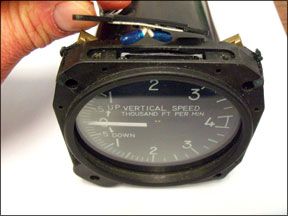It was close to midnight and after a long day of flying we were cooked. A couple miles out something just didnt look right. If not for the landing light reflecting off the trees, we might not be here to review cockpit lighting upgrades. The instrument-panel lighting in that 70s-vintage Arrow was so poor we cranked in the wrong altimeter setting-misreading a two for a three in the Kollsman window. There’s no reason to live with (or risk death due to) substandard cockpit lighting. Panel upgrades require skill and a decent budget. The good news is there are several options to light up your night.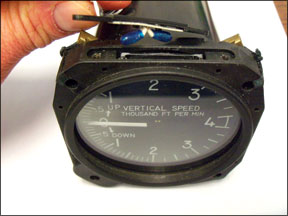
Some Human Factors
Studies continues to prove that certain combinations of instrument panel paint and lamp color play a huge role in reducing pilot fatigue during night ops. Soft blue lighting is known to combat eye fatigue and it, along with a flat grey panel, is perhaps the easiest on the eyes in a darkened cabin. While high-gloss wood-grain look-alike finish combinations are as glamorous in a Skylane as they are in a Jaguar, they might not promote a fatigue-free view in flight. We recommend thinking practically to find the proper balance between aesthetics and functionality.
The ability to dim all the lights is important. Dont underestimate the distraction even a single bright warning light can induce in an otherwise well-dimmed cockpit. A piece of black electrical tape over the annunciator isn’t the acceptable remedy.
Internal lamps and Posts
Internal lighting for instruments usually relies on a lamp tray seated in the upper portion of the instrument bezel. Its not the best lighting, but it works.
It also costs. The non-lighted Sigma Tek 5000B-36 gyro is $1040, while the 5000B-37 with lighting is $1230 plus a $55 lamp tray. In a world where many owners are trying to move out of round-gauge instrumentation, any added costs for replacement seems silly.
Post lamps are a common if frustrating source of instrument light. It seems there are always one or two lamps that are burned out, given their somewhat fragile design. These breakable lamps mean extra work during instrument maintenance. But if you need them, Whelen offers post lamps at $37 each.
Lit Rings and Wedges
Lighting rings and wedges are a common solution for improved lighting and give the appearance of an internally-lighted instrument. Further, the light is directed inward to help eliminate the blinding effect and parallax created by some internally lighted instruments.
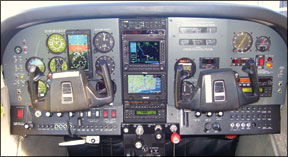
Nulite Instrument Lighting Systems are a popular solution. The amount of light generated by a Nulite is about the same as that of an internally-lighted instrument, with 60 percent of the illumination focused on the upper half of the instrument to reduce glare. Nulites can be mounted sandwiched between the instrument and the panel, or, if the aircraft has a “false panel” overlay, placed over the panel structure and under the overlay. Nulites can work with an existing lighting dimmer circuit and the wedges come in 5-, 14- and 24-volt flavors. Wired in a parallel circuit, a dozen lamps will draw one amp of current. The Nulites come for either 3 1/8-inch or 2 1/4-inch size instrument holes. The lights are warranted for life, which is published at 16,000 hours. Each wedge is $42.50.
Instrument manufacturer UMA Instruments has a similar lighting concept with their EL-series of light bezels. The UMA lights are solid-state electroluminescent light strips rather than incandescent bulbs. Since they require AC input voltage, a DC-AC inverter must be installed. Each inverter can handle up to 12 bezels. Lights are available in multiple colors, including aviation green, red and white. White, however, is the only color that carries FAA PMA approval. UMA says their wedges have a life of approximately 5000 hours.
Electroluminescence gives more uniform lighting coverage and, since UMA lamps have strips that provide coverage around the entire instrument, they are highly effective while generating little if any heat. Each lamp is $49.50, the lighting inverter is $53 and the dimming potentiometer (which can drive up to 12 instruments) is $20.25. Given the need for the inverter, a UMA system will cost more than Nulites. But our experience is that electroluminescent lighting is superior to incandescent.
SPT Superior Panel Technology has the Fibrelite fiber-optic lighting system. These optical ribbons can evenly illuminate a large area and create a uniform glow around instruments. A single LED can illuminate up to three 3 1/8-inch instruments or six 2 1/4-inch instruments. The lighting is sandwiched between the panel and instruments and can be connected to a solid state dimming system and a battery pack. Fibrelite has STC with AML and a lighting package sells for $254.95.
New Panel, New Lights
Fabricating a non-structural overlay, or “false panel,” can modernize an otherwise dated look. But the real benefit is the custom overlay can be made with integral lighting built in. Pfluegers Custom Panels in Trinity Center, California, manufactures such custom overlays.
The process is lengthy and there’s often a fair amount of effort to install the finished product. However, the imbedded recessed lighting in the overlay offers useful and uniform instrument lighting. The potential drawback is the instruments might appear recessed into the panel given the thickness of the overlay. Still, Hal Pflueger told us the lighting in his panels will last forever.
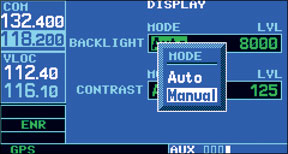
NightFly illuminated panel overlays are acrylic plastic (similar to the material used on aircraft windows). The panels attach to metal backplates usually made of T-6 or T-3 aluminum. The overlays have integrated lighting and placarding and are available in multiple color schemes. We werent able to confirm prices as of this writing, but the NightFly web site (www.nightflypanels.com) boasts of pricing that starts at $1500 for basic panels. The company said a 337 and logbook entry are required for return to service. They also offer lighting wedges.
Glareshield Lighting
Glareshields are more than cosmetic. They shield the panel from glare, of course, and can be a barrier between the panel and your noggin if you were to crash. Glareshield, or brow lighting as its also called, adds more utility with light that enhances other panel lighting sources and can light up non-lighted toggle switches and controls.
Unfortunately, few replacement glareshields seem to carry FAA approval. Aircraft Spruce carries Ashby Aircraft glareshields. The model equipped with lighting to fit a Cessna sells for under $500. There will be some labor involved for installation as they just arent an exact fit.
For add-on, SPT offers the Fibrelite Glow Strip electroluminescent system. These strips are 18 inches long by one inch wide, and provide soft green illumination. The strips are flexible so they can contour with the shape of the glareshield. The rub here is no FAA approvals are in place yet so technically, theyll need to be FAA Field Approved. The electroluminescent strips require a supplied inverter, which will need to be installed and wired. A single strip with inverter is $119.
As for avionics lighting, nearly all modern stack-mounted systems have integral lighting with displays controlled by photo-detector for automatic dimming. Some units with color screens allow for contrast and brightness adjustments for ultimate customization. Avionics, including navigational indicators, are commonly wired to an avionics lighting circuit
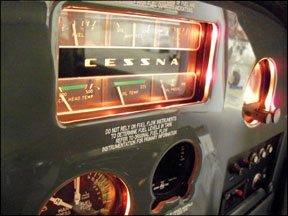
that has a dedicated dimmer.
See the Light
When it comes to panel lighting upgrades, many owners leave it up to the shop to install a system that simply offers useful night lighting. Given all the options, you can do better.
If a custom overlay or new instrument panel is being fabricated, you’ll want to be closely involved in the design process to be sure all the switches and instruments are arranged per your liking. Even if youre sticking with as much original stuff as practical, be sure you know just how much the shop is replacing or keeping.
Keep in mind that the type of lighting system you use isn’t as important as the reliability of the dimming circuit being used to drive the lights. A modern lighting system offers nothing if the dimmer and lighting power supply fail. VAL Avionics offers the CLA500 cockpit lighting assembly, which features a solid state dimmer assembly that has four independent dimming output circuits. Each circuit has a dimmer potentiometer for mounting on the panel. It sells for $250.
Dont underestimate the value and expense of modern and reliable lighting. As we discovered one dark night, lighting upgrades can be a life-saver.

